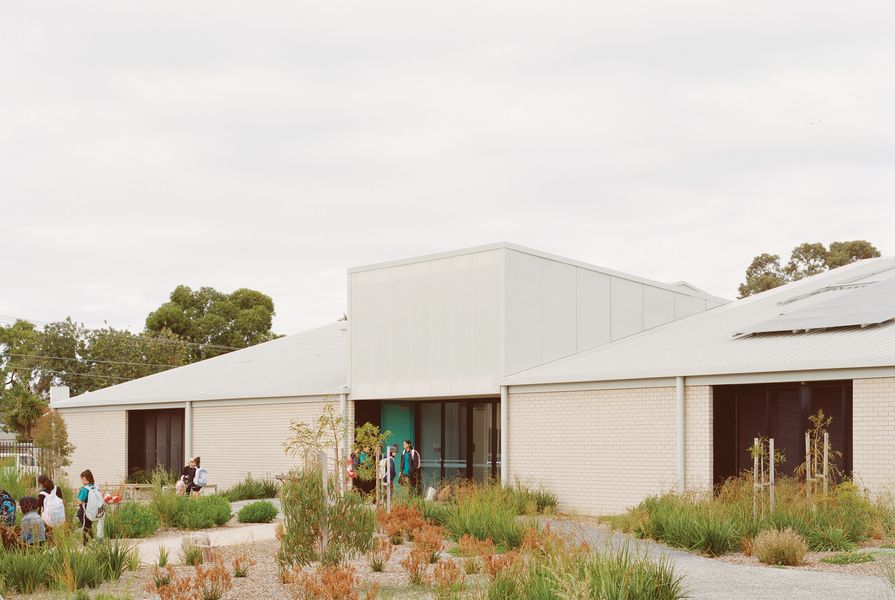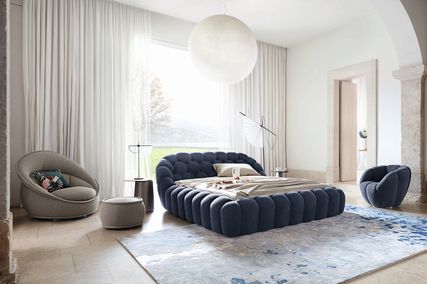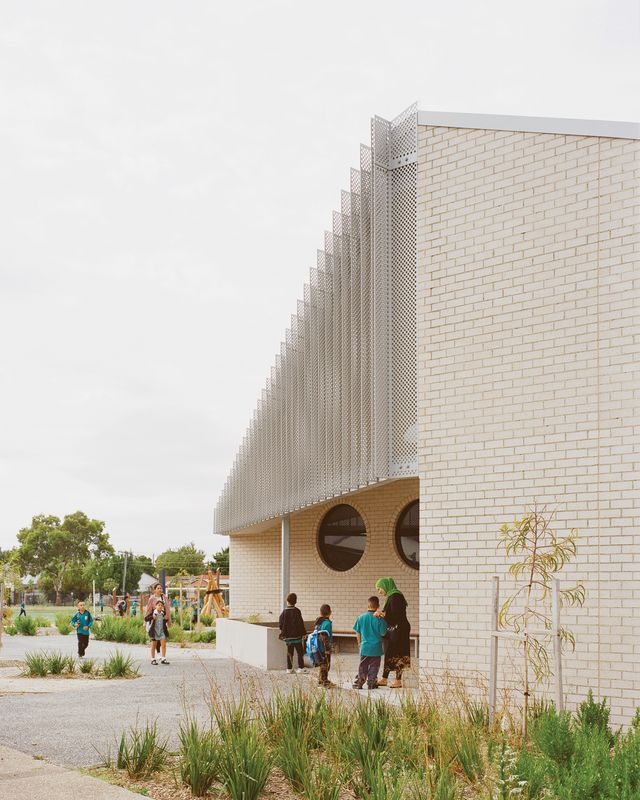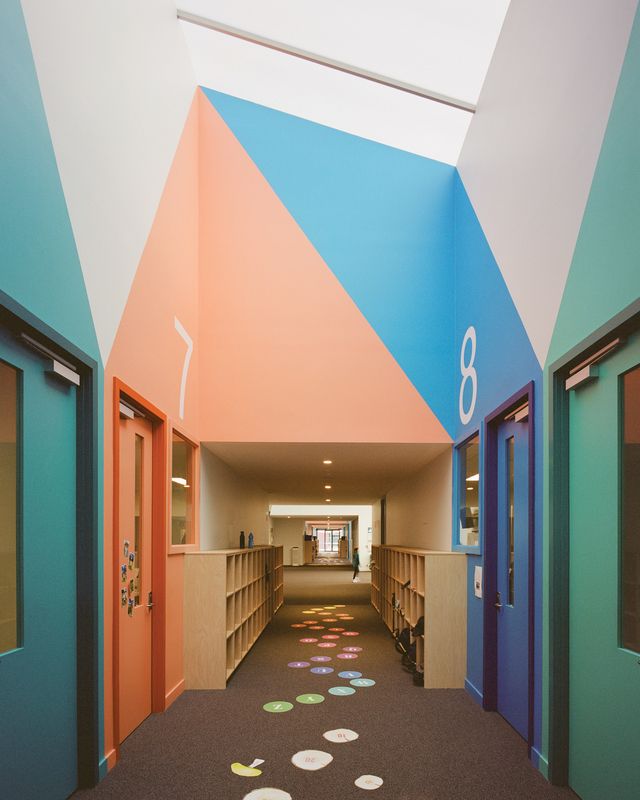Located in the fast-growing suburb of Broadmeadows on the unceded lands of the Wurundjeri people of the Kulin nation, Meadows Primary School was given funding to upgrade its existing facilities to accommodate an extra 200 students by 2020. Working with a tight budget and an accelerated construction timeline, Project 12 Architecture – alongside Meadows Primary staff, the Victorian School Building Authority (VSBA), Alchemy Construct and Simon Ellis Landscape Architects – has delivered a series of new spaces and structures that supports the specific experiences and expertise within the school community.
Like so many education projects constructed in Australia over the past 20 years, the existing learning spaces at Meadows Primary are flexible learning hubs – large, open-plan volumes designed to accommodate multiple concurrent classes and a range of teaching and learning activities. The prevalence of these larger “free” spaces, and the sense that architecturally reformed learning environments might be required to translate innovative pedagogical approaches, are not new. Open-plan schooling strategies emerged in Australia and elsewhere during the 1960s, promising a level of freedom from the confines and hierarchies of the traditional classroom space. As Julie McLeod and Lisa Rosén Rasmussen have observed, at that moment, spatial openness “stood for reimagining schooling as a social institution and to possibilities for remaking student and teacher subjectivities.” 1 Such compelling connections have endured within education design, even in the absence of clear evidence that they improve student learning outcomes. 2
As well as new classrooms, a staff workroom and a collaboration space, the design includes surrounding outdoor areas and a playground.
Image: Rory Gardiner
Set against this context, the decision to design the new building at Meadows Primary based on a fixed-classroom model is of particular interest because it required an interrogation of broader terms like “student-centred” and “flexible” to ask what they might mean here, within this school, and at this moment in time. While the upgraded facilities move away from open-plan learning environments in favour of more fixed and segmented spaces, the project offers a wide range of possibilities and experiences that are nevertheless tailored to the particular needs of these students. By prioritizing acoustic separation between spaces, and with the provision of smaller internal and external spaces for self-regulation, students are supported to direct their attention to learning activities during class time, while also being able to access quiet sensory rooms when needed.
The Meadows Primary school community is culturally and linguistically diverse, with the majority of students learning English as an additional language. Of these students, a significant number have recently arrived in Australia, and some families within the school community also have refugee status, experiences of trauma and/ or ongoing instability. Anthony Potesta, the principal of Meadows Primary from 2017 until 2023, recalls that Project 12’s commitment to hearing and learning from the school community was evident from the very first meeting during the tender process, which typically involves each practice visiting the school and project site: “They really wanted to know more, to learn more about trauma-informed teaching approaches, high-level behavioural needs and how our students attain and retain information.”
Wide eaves and seating encourage small informal gatherings around the edge of the building.
Image: Rory Gardiner
While Project 12 was established in 2011, the practice moved into education design relatively recently, with successful tenders for smaller alterations and additions projects leading to larger jobs such as the new build at Meadows Primary and a competition-grade gymnasium at Cowes Primary School on Phillip Island. Project 12 co-founder and director Aimee Goodwin reflects that a significant aspect of the practice’s success in this area seems to relate to conversations that take place before any specific design proposals take shape. “After developing an understanding of the project deliverables and systems, where we’ve cut through, I think, is on the school visit with the principal. When you listen to what they’re saying and where they’re having issues and then present back to them a series of approaches outlining how you might address these, you’re not designing anything yet, but what you’re saying is, ‘We’ve heard you, and we’re going to respond.’”
Situated on the south-west corner of the site, the new single-storey structure includes 10 classrooms, two small-group learning rooms, and a staff workroom and collaboration space, as well as bathrooms for students and staff, storage and printing rooms. These rooms are arranged along a generous central spine that can be used for smaller group or individual teaching and learning. Funded through the VSBA’s Established Areas Program, the project also includes the design of surrounding outdoor areas and a play-ground to the eastern edge of the new building. The efficiency of Project 12’s design meant that there was also a small amount of the project budget available for the retrofitting of five more classroom spaces within an existing learning hub.
The new teaching and learning spaces have access to natural light, with views judiciously offset to avoid student distraction.
Image: Rory Gardiner
Each new teaching and learning space has access to natural light and views of the surrounding landscaping, but the openings are offset from student desks and tables to avoid distraction. Classrooms along the project’s western edge open out onto paved areas; tucked under wide eaves, these areas serve as extra teaching space as well as providing students with opportunities for self-regulation.
The project gathers the school’s new spaces together under a long gable roof, which is subtly manipulated across each facade in conversation with surrounding conditions. Picking up on cues from its residential context, the flatness of the white gable end at the southern (Cooper Street) elevation is punctuated by a recessed black door frame. Overhead, polycarbonate cladding accentuates the entrance and hints at the presence of spaces behind through out-of-focus glimpses of structural elements and a subtle glow. At the main entrance and presentation area on the project’s western edge, a skillion roof breaks the continuity of the gable form, once again making clever use of polycarbonate’s lantern-like qualities to guide users toward the structure’s entry points.
Colour and geometry are used as wayfinding elements along the building’s main corridor.
Image: Rory Gardiner
Project 12 has extended the opportunity to consider a deeply student-focused approach well beyond the building’s interior. For example, by situating student bathrooms outside the line of enclosure and making their location visible using colour, the design establishes connections with the new playground area. A thoroughly primary-scaled, covered outdoor seating area to the north – what Goodwin refers to as the “Pokémon trading card area” – encourages small informal gatherings around the edge of the building.
There’s nothing conspicuously “new” about the new spaces at Meadows Primary; the additions are unselfconscious and seemingly uninterested in making a loud statement about architecture’s capacity to reform educational environments. Instead, Project 12 has achieved a thorough understanding of the specific needs and perspectives of educators and pupils at Meadows Primary and used this as the driver for design decisions. While this apparently simple act of listening to client and user needs is often quoted as a fundamental aspect of architectural practice, Meadow Primary demonstrates the level of care and attention involved in genuinely and wholeheartedly providing responsive architectural services and outcomes. For Potesta, the new building’s biggest test came straight away, in the immediate aftermath of COVID-related lockdown conditions, as students transitioned back to in-person learning, and staff shortages and intense workloads put further pressure on educators.
“I’m not sure that we would have gotten through the post-lockdown period [without the new spaces]. Our teachers had the knowledge and skills to support our students, but they also needed an environment in which they could deliver.”
- Julie McLeod and Lisa Rosén Rasmussen, “Open-plan schooling and everyday utopias: Australia and Denmark in the 1970s,” Oxford Review of Education , vol. 47, no. 5, 2021, 659–80; doi.org/10.1080/03054985.2021.1958771.
- Anika Stobart and Jordana Hunter, “Open-plan classrooms are trendy but there is little evidence to show they help students learn,” The Conversation , 13 February 2023; theconversation.com/open-plan-classrooms-are-trendy- but-there-is-little-evidence-to-show-they-help-students-learn-199591.
Credits
- Project
- Meadows Primary School
- Architect
- Project 12 Architecture
Vic, Australia
- Project Team
- Aimee Goodwin, Louis Gadd, Belle Wang, Estelle Peter, Adam Smith
- Consultants
-
Access consultant
Architecture and Access
Acoustic consultant Octave Acoustics
Builder Alchemy Construct
Building surveyor Design Guide Consultants
Landscape architect Simon Ellis Landscape Architects
Project manager The APP Group
Quantity surveyor Turner & Townsend
Services engineer BRT Consulting
Structural and civil engineer OPS Engineers
- Aboriginal Nation
- Built on the land of the Wurundjeri people.
- Site Details
- Project Details
-
Status
Built
Category Education
Type Schools
Source
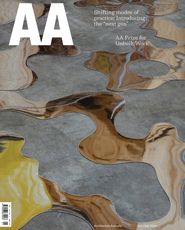
Project
Published online: 15 Feb 2024
Words:
Alexandra Brown
Images:
Rory Gardiner
Issue
Architecture Australia, January 2024

